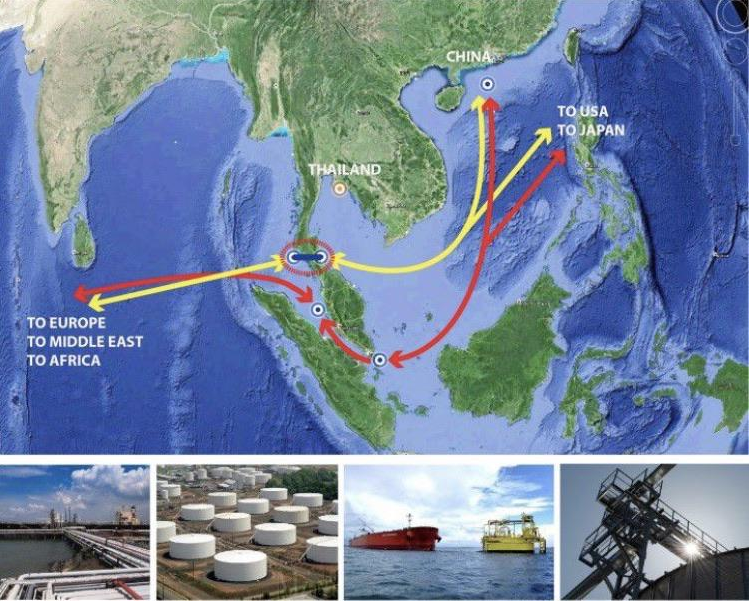
- While the Thai land bridge can reduce Beijing’s reliance on the Malacca Strait, it can potentially shift the balance of power in the Asia-Pacific region.
- If China were to succeed in bypassing this chokepoint, the U.S. would certainly lose a key leverage in influence, weakening its strategic stand in the region.
- As Thailand and China progress with this project, any delay in U.S. intervention could result in a dramatic shift in the balance of power in the Asia-Pacific, with far-reaching implications for global trade, security, and stability.
Thailand’s strategic plan to develop a land bridge connecting the Gulf of Thailand and the Andaman Sea is attracting significant international attention, particularly from strategic analysts in Washington. While this project can solve Beijing’s Malacca dilemma by reducing its reliance on the Malacca Strait, it can potentially shift the balance of power in the Asia-Pacific region. If the United States does not respond effectively to these developments, China’s ascent as a global trade superpower could become more firmly established.
The Malacca Dilemma: A Strategic Weakness
China’s “Malacca Dilemma” stems from its heavy reliance on the narrow Strait of Malacca for oil imports and trade, making it vulnerable to potential blockades by naval powers due to the strait’s strategic importance. To mitigate this risk, Beijing is exploring alternative routes, such as the proposed Thai land bridge across the Kra Isthmus, which would provide direct access to the Indian Ocean without passing through the Malacca Strait. By developing deep-sea ports and a rail and road network in this region, China aims to reduce shipping costs, increase its competitiveness in global markets, and avoid the risks associated with the Malacca chokepoint. This strategic initiative would not only bolster China’s economic resilience but also enhance its geopolitical leverage over other nations dependent on the same maritime routes. Ultimately, bypassing the Malacca Strait via the Thai land bridge would strengthen China’s power projection in the Indian Ocean, reduce the threat of a US-led blockade, and secure its long-term interests in maritime trade.
What Must US Do?
Allowing China to establish an alternative trade route with Thailand would be a colossal strategic blunder for the United States. The U.S. Navy’s control over the southern exits of the Strait of Malacca has long served as a critical advantage, deterring Chinese aggression and providing leverage in conflict situations. Should China succeed in bypassing this chokepoint, the U.S. would lose a vital tool of influence, significantly weakening its strategic position in the region. The construction of a Thai land bridge would also accelerate the expansion of China’s Belt and Road Initiative (BRI), allowing Beijing to deepen its economic and political influence in mainland Southeast Asia. By aligning itself closely with China, Thailand could shift the regional balance of power, potentially undermining the U.S.-led security framework that has maintained stability in the region for decades.
This situation calls for a multifaceted U.S. strategy aimed at dissuading Thailand from becoming overly dependent on China by participating in the project. The U.S. should negotiate by offering economic benefits such as increased infrastructure investments and favourable trade deals, among other incentives. Additionally, the strategy should include strengthening relations with other regional allies, such as India, Vietnam, and Indonesia, to counterbalance China’s growing influence and prevent its dominance in the region.
Implications for Global Trade
If China gains access to the Indian Ocean, it will not only bolster its security presence but could also elevate its status from a regional power to a superpower in global trade. By bypassing the Malacca Strait, shipping times could be reduced by several days, giving Chinese goods a significant competitive edge in markets across South Asia, the Middle East, and Africa. This strategic shift would expedite the transformation of global trade patterns, with more goods flowing through China-centric routes, thereby increasing Beijing’s control over critical supply chains.
Over time, this would lead to a reorientation of global trade networks with China at the centre. As a result, the U.S., Europe, and other major economies would become increasingly reliant on routes and infrastructure under Chinese control, diminishing their ability to challenge Beijing’s economic policies or apply leverage on issues such as human rights and intellectual property theft.
Way Forward
The Thailand land bridge is far more than a mere infrastructure project; it is a key element in China’s grand strategy to address one of its most significant vulnerabilities and to secure a dominant position in global trade. The U.S. cannot afford to stand idly by as China strengthens its influence in the Asia-Pacific and beyond. To maintain its strategic edge, the U.S. must act decisively to consolidate its primacy and ensure that this development does not unfold to China’s advantage and to the detriment of U.S. interests and international stability.
The time to address this strategic challenge is now. As Thailand and China progress with this project, any delay in U.S. intervention could result in a dramatic shift in the balance of power in the Asia-Pacific, with far-reaching implications for global trade, security, and stability. The U.S. must leverage its diplomatic, economic, and military tools to prevent China from bypassing the Malacca Dilemma and reshaping the global trade landscape to its advantage.
(Lipun Kumar Sanbad, a Master’s student in Politics and International Relations at Pondicherry University, specializes in global affairs and strategic studies. He has published research in the International Journal of Legal Studies and Social Sciences and presented at various conferences. Views expressed are the author’s own)
References:
- https://asiatimes.com/2024/08/blocking-thailands-solution-to-chinas-malacca-dilemma/
- https://thailand-construction.com/thailands-proposed-land-bridge-a-project-for-no-one/
